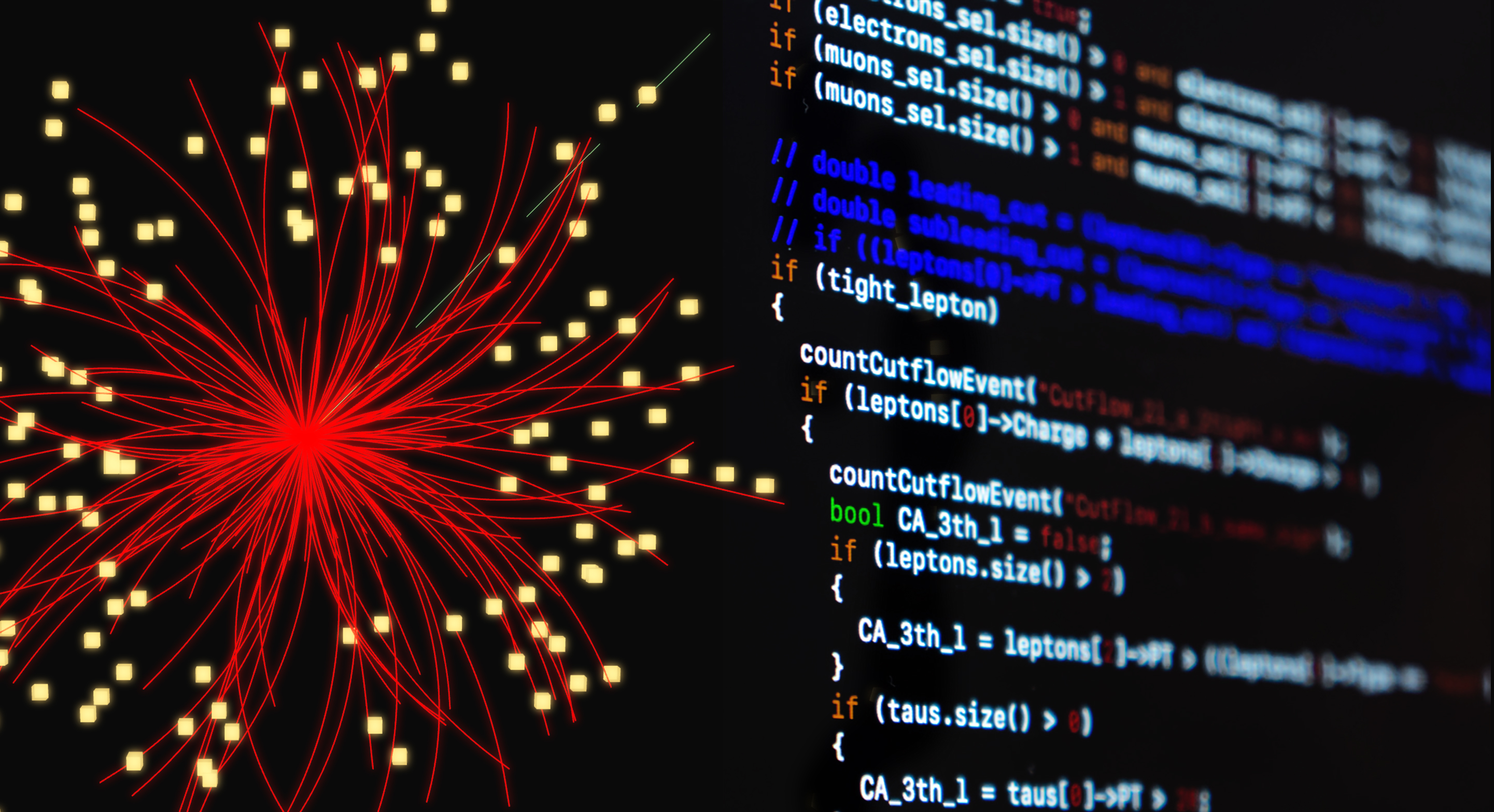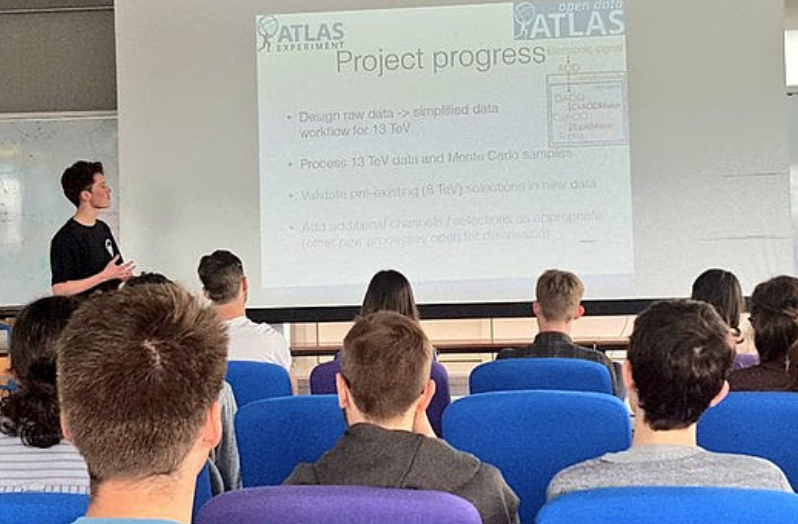New open release streamlines interactions with theoretical physicists
12 December 2019 | By

What if you could test a new theory against LHC data? Better yet, what if the expert knowledge needed to do this was captured in a convenient format? This tall order is now on its way from the ATLAS Collaboration, with the first open release of full analysis likelihoods from an LHC experiment.
“In particle physics, experimentalists develop a very rich summary of measurements, which account for all relevant scattering processes and every source of uncertainty, encapsulated into what we call likelihoods,” explains Lukas Heinrich, CERN research fellow working for the ATLAS Experiment. “Likelihoods allow you to compute the probability that the data observed in a particular experiment match a specific model or theory. Effectively, it summarises every aspect of a particular analysis, from the detector settings, event selection, expected signal and background processes, to uncertainties and theoretical models.” Extraordinarily complex and critical to every analysis, likelihoods are one of the most valuable tools produced at the LHC experiments. Their public release will now enable phenomenologists around the world to explore ATLAS data in a whole new way.
The ATLAS open likelihoods are available on HEPData, an open-access repository for experimental particle physics data. The first open likelihoods released were for a search for supersymmetry in proton–proton collision events containing Higgs bosons, numerous jets of b-quarks and missing transverse momentum. “While ATLAS had published likelihood scans focused on the Higgs boson in 2013, those did not expose the full complexity of the measurements,” says Kyle Cranmer, Professor at New York University. “We hope this first release – which provides the full likelihoods in all their glory – will form a new communication bridge between theorists and experimentalists, enriching the discourse between the communities.”
The search for new physics will benefit significantly from open likelihoods. “If you’re a theorist developing a new idea, your first question is likely: ‘Is my model already excluded by experiments at the LHC?’” says Giordon Stark, postdoctoral scholar at SCIPP, UC Santa Cruz. “Until now, there was no easy way to answer this.” Most LHC searches focus on certain benchmark models, giving a detailed analysis of the data to make a statement on whether or not the Standard Model holds in the considered processes and, if so, which model parameters are still allowed and which are excluded by the data. But, of course, any search analysis is sensitive to numerous new physics scenarios.
Using publicly released likelihoods, theorists will now be able to alter the original hypothesis studied by ATLAS. While such results may not reach the accuracy of the original result – given the missing step of simulating the putative processes in the ATLAS detector – they will give theorists a quick assessment of the potential of their new theory.
Using these publicly-released likelihoods, theorists will now be able to alter the original hypothesis studied by the ATLAS Collaboration.
Providing the tools for open analysis
But why do you need likelihoods to understand ATLAS data? Like many public scientific datasets, data from LHC experiments can be impenetrable without domain-specific knowledge. Before it can begin to make sense, one needs to account for a vast set of detector and software parameters, as well as complex theoretical modelling.
“Instead, the ATLAS Collaboration has focussed on open data resources,” says Matthew Feickert, postdoctoral research associate at the University of Illinois at Urbana-Champaign. “It is our responsibility to minimise the complexity that stands between theorists and the relevant ATLAS information. There are many valuable questions that theorists outside of the ATLAS experiment can help us answer, and we need to give them the best tools to do so.”
Since the early days of the LHC, there has been strong consensus between the experimental and theoretical physics communities that this could best be done by publicly releasing analysis likelihoods. The formats that have been developed internally by the experiments to share likelihoods are not well suited for publishing or easy use by the theoretical community. “Recently, we rewrote the software for likelihoods to take advantage of machine learning frameworks, and realised it also offered the opportunity to address the publishing problem," explains Heinrich. “We also ensured that we chose human and machine-readable formats with ubiquitous, long-term support. That way, even as technologies and software evolve, the likelihoods will still be useable.”

Ensuring the future of open physics
“We plan to make the open release of likelihoods a regular part of our publication process, and have already made them available from a search for the direct production of tau slepton pairs,” says Laura Jeanty, ATLAS Supersymmetry working group convenor. “Over the coming months, we aim to collect feedback from theorists outside the collaboration to best understand how they are using this new resource to further refine future releases.”
The public release of full likelihoods will also bring with it significant benefits for experimentalists. “Likelihoods are an essential ingredient for combining analyses from different experiments,” says Stark, who organises the statistical combinations of ATLAS supersymmetry results. “As their open release becomes more common place, I look forward to seeing larger-scale statistical combinations.”
In parallel, the ATLAS Supersymmetry and Exotics working groups have also established a new approach to analysis preservation. “These are parts of our efforts to ‘future-proof’ ATLAS results,” explains Federico Meloni, ATLAS Supersymmetry working group convenor. “As theorists develop new ideas, ATLAS data may need to be re-examined. As such, we are now archiving the software and analysis tools used in the result prior to its publication. This will ease future reinterpretations of the data, years down the line.” When these archived analysis pipelines are paired with published likelihoods, physicists will be equipped with a transformative capability: the ability to test a new theory against the data in an automated fashion.
Together, these developments mark a new approach to open and reproducible research at the LHC. The ATLAS Collaboration will continue to focus on creating rich, preservable open access tools – such as the open likelihoods – and looks forward to the compelling new insights they create.
Find out more
- Explore the first open likelihoods released: Search for bottom-squark pair production with the ATLAS detector in final states containing Higgs bosons, bb-jets and missing transverse momentum (DOI: 10.17182/hepdata.89408.v1/r2) and Search for direct stau production in events with two hadronic ττ-leptons in 13 TeV proton-proton collisions with the ATLAS detector (DOI: 10.17182/hepdata.92006).
- Learn about how the open likelihoods were created and how to use them: Reproducing searches for new physics with the ATLAS experiment through publication of full statistical likelihoods (ATL-PHYS-PUB-2019-029).
- Recent talk by Matthew Feickert at CHEP 2019: Likelihood preservation and statistical reproduction of searches for new physics



